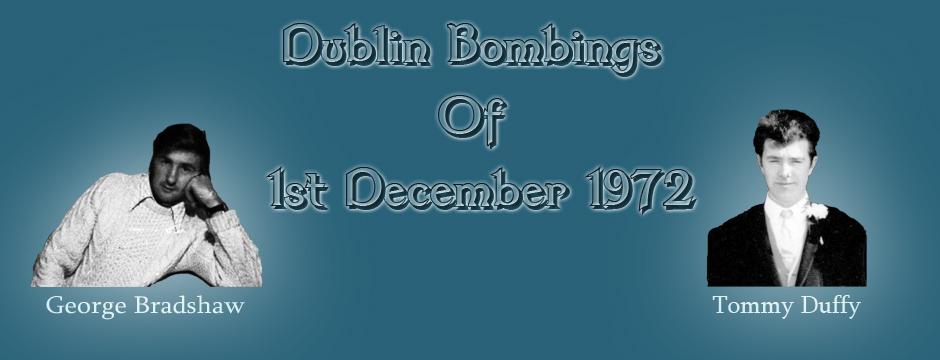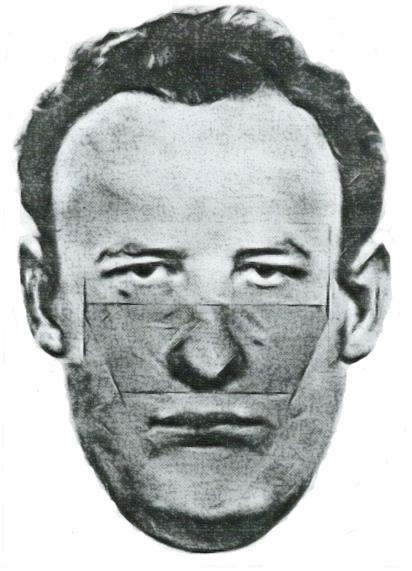DUBLIN BOMBINGS OF 1st DECEMBER 1972

1st December 1972
At 7.58 pm on the winter evening of 1 December 1972, a car bomb exploded near Liberty Hall, Dublin. There were no fatalities but many people were injured. At 8.15pm a second car bomb exploded at Sackville Place, off O'Connell Street, killing a bus driver George Bradshaw (30) and a bus conductor Tommy Duffy (23).
Three minutes before the first bomb exploded, an anonymous telephone call was received by the Belfast Newsletter, giving a warning that bombs were planted at Liberty Hall and behind Clery's and would explode at 8.05 pm. The man who received the warning told the RUC that the caller had spoken with a "distinctly English accent". The warnings came too late as was almost certainly the intention. The result was devastating, two dead and 127 people treated in various city hospitals. The damage to property was extensive.
Political Context
On the same evening of 1st December 1972, the Dáil (Irish Parliament) was in session at Leinster House, Dublin. A Bill to amend the Offences against the State Act was being debated and a defeat for the Fianna Fáil Government appeared inevitable as the opposition parties and some members of the government party were opposed to the amendment. The Bill was intended to strengthen the government's hand in dealing with the IRA. By late that evening two car bombs were to alter the course of Irish history.
The bombings had an immediate impact politically. In the Dáil, the Fine Gael Party immediately withdrew their objection to the Bill and supported its passage into law. The middle ground in politics had shifted away from Civil Liberties and public opinion had moved towards a rejection of violence.
Were the bombs the actions of loyalist paramilitaries from Northern Ireland or were they the actions of British forces or security services set upon shaping the political response of the Irish Government to the unfolding troubles in Northern Ireland?
Early Criminal Investigations
Investigations centred around four cars, which appeared to be connected with the bombings. The cars in which the bombs were planted were both hired in Northern Ireland on Thursday, 30 November and were due to be returned on Saturday, 2 December.
One car was hired from Moley's Car Hire Company, Victoria Square, Belfast by a man who produced an English driving-licence in the name of Joseph Fleming of Derby, England. He was described by Mr. Phil Moley, the firm's owner, as "a respectable, well-dressed man of about 40, six feet tall and speaking with an English accent with an Irish intonation". This car exploded in Sackville Place. A Garda source said it had been parked there about 5 pm. An internal Gardai photofit was subsequently issued on the 5th of December 1972 and can be found below:
1st December 1972 Photofit
The information below relates to a photofit illustration and documentation circulated internally by the Gardai in the aftermath of the incident.
5th December, 1972. SUPPLENENT No. 4/72.
All communications for insertion in Fogra Tora Part I, should be forwarded to Fogra Tora Section,
Technical Bureau, Kingsbridge, Dublin 8, with "Fogra Tora" in top left hand corner.
BOMB OUTRAGES IN DUBLIN CITY ON 1/12/72.
Refer to Special Supplement to Fogra Tora Part 1, No. 3/72, dated 4/12/72.
Herewith Photo-FIT illustration of the man described as the hirer of the silver/grey Escort motor car, Reg. No. 9551-vz, hired from Moley's Car Hire Firm, 49, Victoria Square, Belfast, at 9.00 a.m. on 30/11/72. This car, containing a bomb, exploded at Sackville Place, Dublin, at 8 p.m. on
1/12/72.

Description: MAN, 40 yrs., 6'O'', 14-15 Stone, round reddish face, fair hair thinning on top and receding. He as wearing a modern style, brown coloured gaberdine over coat, well dressed appearance, and looked like a business man; spoke with a cultured North of Ireland or English accent.
Enquiries, as previously directed, should be continued at Hotels, Guest Houses, Air, Boat, Bus and Train termini, and all likely places, in an endeavour to trace or obtain further information on this man.
Issued by the Garda Technical Bureau.
Another car was hired from Avis at Aldergrove Airport, Belfast. The hirer told Avis that he was employed by Lloyd's Insurance Company in Derby. Avis were satisfied that the hirer was an Englishman and spoke with an English accent. This car exploded at Liberty Hall.
The third car was hired from Hertz at Aldergrove Airport, Belfast and was due for return the same day as the other two. The hirer failed to return the car. A fourth car, the property of a Mr. Joseph Fleming of Derby, England had been stolen in County Antrim some time previously and had not been located. The car contained his driving-licence, which would appear to have been used to hire all three cars.
The Campaign
The Independent Commission of Inquiry into the Dublin and Monaghan bombings extended its remit to include an investigation of these bombings. Its report, which was very inconclusive, was published on 17 November 2004. In January and February 2005 the report was subsequently examined, including in public session, by the Joint Oireachtas Committee on Justice, Equality, Defence and Women's Rights. The Committee published its report on 16 February 2005.
In its recommendations the Committee deplored the lack of co-operation from the British authorities and declared it impossible to reconcile their stance with the Good Friday Agreement. The Committee stated that it intends to return to the issue and will consider asking the Houses of the Oireachtas to permit it to re-convene to specifically address the issue.
A Victims' Charter was recommended and the Minister for Justice was required to raise the issue with the relevant British authorities with a view to establishing a Victims' Charter for all the victims of the Troubles.
It further recommended that the Minister for Justice establish a committee of independent academics who will advise the Department on access to undisclosed files in the National Archives at the earliest possible opportunity.
It recommended that the Minister for Justice extend the terms of reference of the Commission of Investigation Inquiry into the Dublin and Monaghan bombings so as to include aspects of the Garda investigation into the Dublin bombings of 1972 and 1973 and the other atrocities in the State from 1970 to 1974, including the missing Clones Garda investigation file into the Belturbet/Clones bombings of December 1972, details of the Crinnion, Wyman and Littlejohn cases and the question of whether or not forensic evidence was properly followed up.
The Committee welcomed the suggestion of the Garda Commissioner that a Liaison Officer be appointed to provide information on past atrocities to the families of victims.
The Committee will consider the request of Justice for the Forgotten that it reconvene later to consider all the evidence that has emerged from the reports of the Independent Commission of Inquiry. Justice for the Forgotten is anxious to return to outline our understanding of all the information and to bring it together in an integrated fashion.
Sadly, to date, the Minister for Justice has failed to implement any of the recommendations of the Committee. However, the Garda Commissioner has appointed a Liaison Officer.
Justice for the Forgotten lodged a complaint against the United Kingdom with the European Court of Human Rights (ECHR) in relation to its utter refusal to co-operate with the second Barron Inquiry. This complaint was rejected by the ECHR on 13th December 2005 on the grounds that it was ill-founded. See Judgement here
We are still awaiting the establishment of a Commission of Investigation into these bombings as recommended in February 2005 by the Joint Oireachtas Committee on Justice, Equality. Defence and Women's Rights.